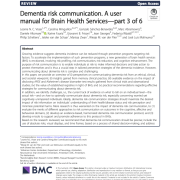Identifying best practices for disclosure of amyloid imaging results: A randomized controlled trial
Agnetha D Fruijtier, Jetske van der Schaar, Ingrid S van Maurik, Marissa D Zwan, Philip Scheltens, Femke Bouwman, Yolande A L Pijnenburg, Bart N M van Berckel, Jarith Ebenau, Wiesje M van der Flier, Ellen M A Smets, Leonie N C Visser
Abstract
Introduction: Empirical studies on effective communication for amyloid disclosure in mild cognitive impairment (MCI) are lacking. We aimed to study the impact of six communication strategies.
Method: We performed a randomized controlled trial with seven randomly assigned, video-vignette conditions: six emphasizing a communication strategy and one basic condition. All showed a scripted consultation of a neurologist disclosing positive amyloid positron emission tomography (PET) scan results to an MCI patient. Healthy individuals (N = 1017; mean age ± SD 64 ± 8, 808 (79%) female) were instructed to imagine themselves in the video, answered questionnaires assessing information recall, emotional state, and behavioral intentions, and evaluate the physician/information.
Results: “Risk best practice” resulted in highest free recall compared to other strategies (P < .05), except “emotional support”. Recall in “emotional support” was better compared to “basic-‘ and elaborate information”(P < .05). “Risk best practice” resulted in the highest uncertainty (P < .001). “Teach-back” and “emotional support” contributed to the highest evaluations (P -values < .01).
Conclusion: Risk communication best practices, attending to emotions, and teach-back techniques enhance information recall of amyloid-PET results, and could contribute to positive care evaluations.











